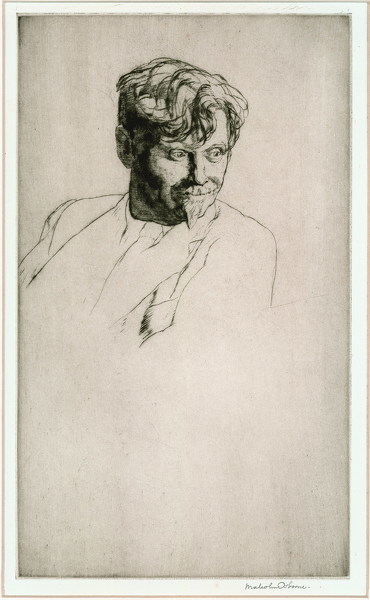
Portrait of Job Nixon, circa 1930
Mounted (ref: 2628)
Etching
Tags: Malcom Osborne etching portraits 1.PORTRAIT OF AN ARTIST

Etching
Tags: Malcom Osborne etching portraits 1.PORTRAIT OF AN ARTIST
Provenance: The Artist's Estate; Private collection
Literature: Llewellyn, Sacha, and Paul Liss. Portrait of an Artist. Liss Llewellyn, 2021, p.228.
Born in Stoke-on-Trent, Nixon
studied at the Slade and at South Kensington and, in 1915, was
successful at the RA whilst still a student. He painted in oil and
watercolour, principally landscape and topographical scenes, but he is
best known for his etchings, drypoints and line engravings, which he
started producing from 1914. His first printed work was an etching and drypoint entitled “The Wooden Plough” of 1914. He was elected ARE in 1923 and, that year,
he won the first competition for the newly endowed scholarship of
engraving at the British School in Rome. Here he met fellow Rome Scholar
Winifred Knights, to whom he later gave this portrait. It was while in
Italy that he produced An Italian Festa, the huge plate that first
brought him to the public's attention. However, the satirical, almost
grotesque, nature of this etching was not his only style and English
genre subjects form the majority of his work. Nevertheless, his
appointment as assistant to Malcolm Osborne in the Engraving School at
the Royal College of Art, South Kensington "came as a shock to the
old-fashioned collector and connoisseur but the soundness of his
technique and his mastery of etching processes, as well as the salutary
influence he exercised in diverting his pupils from too slavish a
pursuit of the landscape tradition, more than justifed his
appointment." Osbourne's portrait of Nixon is likely to date to this
period.
Nixon started to exhibit watercolours with the RWS in
1928 and, over the next decade, exhibited with the Society some 93
times, becoming an associate member in 1934. His watercolours do betray
his primary calling, with line drawing prominent, and the subjects often
the same, but he was complimented on his virile use of line and lively
and generous love of colour. Two Falmouth scenes shown in 1929 indicate
that he had paid a visit to Cornwall. One of the most stalwart
supporters of the RWS at that time was Lamorna Birch and it was Birch,
apparently, that persuaded Nixon to move to Cornwall in 1931 where he
initially settled in Lamorna, working from Riverside Studio. In his
first exhibition with the Newlyn Society of Artists, his large oil of a
Romany encampment, entitled Gypsies, was awarded the position of honour
and attracted considerable attention, due to its daring colour
selection, unconventional composition and "modern" drawing style. In
1934, he moved to St Ives, where he briefly ran a School of Painting in
Back Road West. The local paper commented, "With his large black hat and
his beard, he fulfilled the conventional idea of what an artist should
look like"and he does seem to have lived a bohemian existence in St Ives
in a caravan. However, the offer of a teaching post at the Slade drew
him back to London in 1935. Sadly, he died in 1938, aged only 47.
(Abridged extract from David Tovey, Creating A Splash : The St Ives Society of Artists (1927-1952), Wilson Books, 2004)
We are grateful to Michael Campbell for assistance.